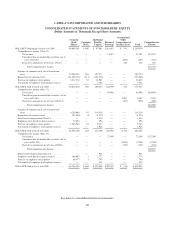Cabela's 2005 Annual Report Download - page 69
Download and view the complete annual report
Please find page 69 of the 2005 Cabela's annual report below. You can navigate through the pages in the report by either clicking on the pages listed below, or by using the keyword search tool below to find specific information within the annual report.Catalog Amortization
Prepaid catalog expenses consist of internal and third party incremental direct costs incurred in the
development, production and circulation of our direct mail catalogs. These costs are primarily composed of
creative design, prepress/production, paper, printing, postage and mailing costs relating to the catalogs. All such
costs are capitalized as prepaid catalog expenses and are amortized over their expected period of future benefit or
twelve months, whichever is shorter. Such amortization is based upon sales lag pattern forecasts, which are
developed using prior similar catalog offerings as a guide. Prepaid catalog expenses are evaluated for
realizability at each reporting period by comparing the carrying amount associated with each catalog to actual
sales data and to the estimated probable remaining future revenue (net revenue less merchandise cost of goods
sold, selling expenses and catalog completions costs) associated with that catalog. If the carrying amount is in
excess of the estimated probable remaining future revenue, the excess is expensed in the reporting period. In
2005 and 2004, we had $37.0 million and $26.6 million, respectively, capitalized at year-end.
Economic Development Bonds
Debt and equity securities with readily determinable fair values are classified as “available-for-sale” and
recorded at fair value, with unrealized gains and losses, net of related income taxes, excluded from earnings and
reported in accumulated other comprehensive income (loss). Declines in the fair value of available-for-sale
securities below cost that are deemed to be other than temporary are reflected in earnings as realized losses.
Gains and losses on the sale of securities are recorded on the trade date and determined using the specific
identification method. At the time we purchase these bonds we make estimates of the discounted future cash flow
streams they are expected to generate in the form of interest and principal payments. Because these cash flows
are based primarily on future property or sales tax collections at our facilities and other facilities (which in many
cases may not yet be operating), these estimates are inherently subjective and the probability of ultimate
realization is highly uncertain. Any excess of par value over fair value of bonds acquired as part of the retail
construction are allocated to the basis of the store. Each reporting period we review the assumptions underlying
the recorded valuation of these bonds to determine whether changes in actual or anticipated tax collections or
other factors suggest that the bonds have become permanently impaired. Future property tax revenue is estimated
using management’s current knowledge and assessment of known construction projects and the likelihood of
additional development or land sales at the relevant sites. Future sales tax revenue is estimated generally using
historical same store sales and projected increases for similar stores. Declines in the fair value of held-to-maturity
and available-for-sale bonds and securities below cost that are deemed to be other than temporary are reflected in
earnings as realized losses. Gains and losses on the sale of securities are recorded on the trade date and
determined using the specific identification method.
Asset Securitization
We use securitization of our credit card loans as one source to meet our funding needs for our Financial
Services business. We account for our securitization transactions in accordance with SFAS 140, issued by the
Financial Accounting Standards Board (“FASB”). When we securitize credit card loans, we recognize retained
beneficial interests, including an interest-only strip receivable. The interest-only strip receivable represents the
contractual right to receive from the trust interest and other revenue less certain costs over the estimated life of
the securitized loans.
We estimate the fair value of the interest-only strip receivable based on the present value of expected future
revenue flows (“excess spread”) based upon certain assumptions and estimates of our management. Quoted
market prices for the interest-only strip receivable are not available and we have limited experience in
performing this type of valuation. Our assumptions and estimates include projections concerning interest income
and late fees on securitized loans, recoveries on charged-off securitized loans, gross credit losses on securitized
loans, contractual servicing fees and the interest rate paid to investors in a securitization transaction. These
projections are used to determine the excess spread we expect to earn over the estimated life of the securitized
57
























